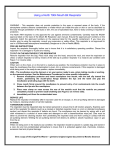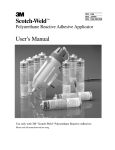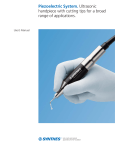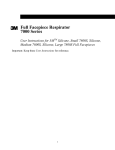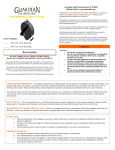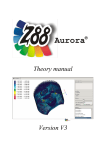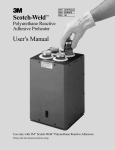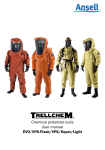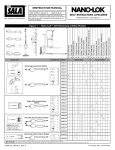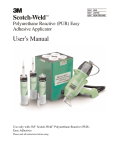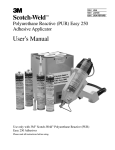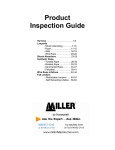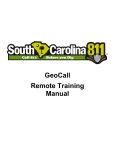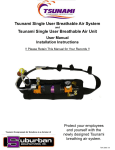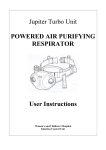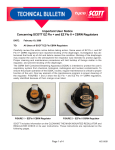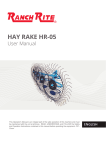Download Product Manual
Transcript
LOOSE-FITTING SUPPLIED-AIR HOOD RESPIRATOR 9816 Series LOW PRESSURE, CONTINUOUS FLOW CLASS OPERATION MANUAL WARNING DO NOT USE this respirator until you completely read and understand this Operation Manual. You are required to inspect your respirator prior to putting it into service. Please refer to the inspection procedures in this manual. Table of Contents I. INTRODUCTION II. SAFETY PRECAUTIONS III. DESCRIPTION IV. PARTS LIST V. USE INSTRUCTIONS A. Air Supply B. Quick Coupler Assembly C. Operation D. Donning E. Using the Respirator F. Doffing VI. MAINTENANCE A. Inspection B. Cleaning C. Repair D. Storage E. Shipment F. Overhaul Frequency G. Additional Information VII. PRESSURE TABLES S. SPECIAL OR CRITICAL USERS INSTRUCTIONS VIII. CAUTIONS AND LIMITATIONS IX. WARRANTY AND LIMITATION OF LIABILITY III. DESCRIPTION SAS SAFETY Supplied-Air Full Hood Respirator provide long duration respiratory protection. Air is supplied to the protective hood through an air supply line. An adapter, clipped to the waist belt, couples the air supply line directly to the breathing tube. Air is supplied to the hood when the air supply line is connected to a compressor or ambient air pump that delivers air at the pressures specified in the tables in section VII. The ANSI Z88.2-1992 classification for the full hood is "hood type continuous flow atmosphere supplying respirator" with an assigned protection factor (APF) of 1000. An APF of 1000 means that this device, when properly used will reduce the exposure by a factor of 1000. 1 1 1 3 3 3 3 4 5 5 5 5 6 6 6 6 7 7 7 8 WARNING • The pressure within the SAS SAFETY 9816-00 Supplied Air Respirator (SAR) hood remains positive under most working conditions, but as with all respirators, negative pressure excursions are possible. Conditions when a respirator can experience negative facepiece pressures include, but are not limited to: 1) the respirator is improperly worn, 2) the respirator is not used in accordance with the instructions, or 3) the respirator is over-breathed during heavy work rates. The 9816-00 SAR respirator will provide reduced protection when operated in a negative pressure mode. • The employer is responsible for establishing that these respirators are suitable for the user's application. • SAS SAFETY cannot predict what will happen to this equipment in every potential environment. Materials can be chemically attacked if exposed to the wrong environment and may exhibit excessive corrosion or other forms of damage. Permeation or penetration of gases, liquids, or particles through the materials could be excessive. Extremes of temperature might cause thermal degradation. Each of these things, or a combination of them, could create conditions in which this SAS SAFETY equipment would be dangerous to use. • Before entering a hazardous environment while wearing SAS SAFETY equipment, you must conduct safe, scientific tests to determine if the environment could render the equipment unsafe. Results of this testing should be well documented. Seek the help of a certified safety professional or industrial hygienist. Do not use this equipment if the user would be endangered in any way through environmentally induced degradation of the materials in the apparatus. • All persons using this SAS SAFETY breathing apparatus must be made aware of its limitations. We cannot be responsible for any damage to property, personal injury, or death in which environmental 8 8 8 I. INTRODUCTION This manual provides operating instructions including cleaning, maintenance, and storage procedures for the SAS SAFETY Supplied-Air Full Hood Respirator, P/N 9816-00. You must read, understand, and follow these instructions and be properly trained before using the respirator in a hazardous atmosphere. II. SAFETY PRECAUTIONS The Warnings, Cautions, and Notes contained in this manual have the following significance: WARNING Maintenance or operating procedures and techniques that will result in personal injury or death if not carefully followed. CAUTION Maintenance or operating procedures and techniques that will result in damage to equipment if not carefully followed. NOTE Maintenance or operating procedures and techniques or information considered important enough to emphasize. 1 WARNING-Continued WARNING-Continued exposed to even minute amounts of contaminant's. This respirator will not prevent health problems for those individuals. • Persons sensitized can have a severe reaction to chemicals at levels well below accepted health levels such as the OSHA Permissible Exposure Limit (PEL), AHIA Threshold Limit Value (TLV), or NIOSH Recommended Exposure Limits (REL). Do not use this respirator if you have been sensitized from previous exposure or believe that you may be sensitive or allergic to any chemical (e.g., isocyanates, latex, etc.) until you obtain clearance from a medical doctor. • Do not modify this respirator in any manner. o This respirator must only be worn and used as specified in SAS SAFETY's instructions. • Always read and follow the instructions listed in the Material Safety Data Sheet for the chemicals that are present in the work area. o Selection and use of these respirators must be done in accordance with ANSI Z88.2, latest edition, and the applicable OSHA statutes. Refer to paragraph III for the ANSI Z88.2, latest edition, classifications for the 981800 and 981820 SARs. • Do not use SAS SAFETY respirators, accessories, and associated equipment in atmospheres which may contain contaminant concentrations above the lower explosive limit (LEL). Intrinsic safety certification of electronic components does not eliminate potential danger from ignition in these atmospheres. • This respirator must be worn and used as specified in SAS SAFETY's instructions. No respirator can provide complete protection from all conditions. Use extreme care for all emergency operations. Do not use this respirator for applications involving exposure to high heat or direct flame. • Some individuals are sensitive to chemicals (e.g., isocyanates, latex, oil mists, etc.) or may have some type of respiratory disorder (e.g., asthma, chronic obstructive airway disease, etc.). If you are sensitive to any chemical or have a respiratory disorder, you may have a severe reaction at contaminant levels well below accepted health levels, such as the OSHA Permissible Exposure Limit (PEL), AHIA Threshold Limit Value (TLV), or the NIOSH Recommended Exposure Limits (REL). Many chemicals (e.g., isocyanates, mercury, etc.) have no physical warning properties and you cannot taste or smell the contaminant's even though they may be present in the respirator facepiece. This respirator will reduce, but will not eliminate the possibility of contaminant's entering the facepiece and causing a severe reaction. Do not use this respirator until you obtain clearance from a medical doctor. exposure is a contributing factor. • Do not use this respirator in concentrations of contaminant's which are unknown or which are immediately dangerous to life or health (IDLH). IDLH atmospheres are defined as: a. Those which the wearer could not breathe for short periods. b. Those from which the wearer could not escape without the aid of the respirator. c. Those which have an immediate or delayed adverse effect on health. • Do not use this respirator at temperatures above 130°F (55°C). • Immediately return to a noncontaminated area if: a. You taste or smell contaminant's, or if your eyes, nose, or throat become irritated. b. Breathing becomes difficult. c. The air you are breathing becomes uncomfortably warm. d. You feel nauseous or dizzy. e. You notice a decrease or loss of air flow. • This respirator does not protect exposed areas of the body. Some contaminant's can be absorbed directly through the skin while others may irritate exposed areas. This respirator hood does not provide protection from splash of hazardous liquids, flying objects, hazardous rays, or harmful noise. Always wear proper head, ear, and eye protection. • This respirator does not supply oxygen and must not be used in atmospheres containing less than 19.5% oxygen by volume. • This respirator must not be used under water, for abrasive blasting, or for interior structural firefighting. The hoods are made of materials with limited flame resistance. Do not expose this respirator to flame, hot embers, sparks, or situations which could cause ignition. • Do not use this respirator in confined spaces. o This respirator must be used in conjunction with a written respirator program meeting the requirements of the OSHA Standard for Respiratory Protection, 29 CFR 1910.134. The program must include procedures for evaluating air contaminant's and selecting appropriate respirators; procedures for proper use of respirators; procedures for cleaning, disinfecting, inspecting, maintaining, and storing respirators; procedures for determining if workers are physically and medically capable of wearing respirators; and procedures for training employees in the use of respirators and in recognizing the hazards associated with contaminant's in the work place. • This respirator will reduce, but will not eliminate the inhalation of contaminant's. Some sensitive individuals may experience health problems when 2 WARNING WARNING-Continued • Compressors, storage cylinders, valves, regulators, fittings, and other hardware must be large enough to deliver the air volume required by all users at peak demand. • You are responsible for air quality and compliance with safety and heal codes applicable to our area. • See the tales in section VII for hose length, air supply pressure, and quick coupler requirements. • Do not mix hose types or coupler assemblies except as specified in the tables in section VII. • Be sure that all respirable air system piping, tubing, fittings, and couplings are incompatible with non-respirable gas systems. • If an air pump or compressor is used to supply breathing air, the following precautions must be taken: a. The air pump or compressor intake must not be located in an area that could possibly contain air contaminant's, such as but not limited to engine exhaust, spray booth exhaust, or other toxic gases. b. The air pump or compressor must have in take and exhaust filters capable of removing dirt, carbon dust, oil, oil vapor, and excess water mist that may be present in the area of the intake or maybe generated within the air pump or compressor itself. Carbon monoxide alarms should be installed on oil- lubricated compressors and in any other situation where carbon monoxide may be present. c. Frequently test the purity of the air delivered by the air pump or compressor. Air pumps and compressors deteriorate with age, and so does the quality of the air they deliver. d. Set the pressure regulator and/or relief valve to maintain the pressure within the range specified in the tables in section VII. • Users must clean and maintain this respirator only in accordance with SAS SAFETY's instructions. Accessories not offered by SAS SAFETY may degrade performance, and will void NIOSH certification. • The respirator facepiece assembly contains natural rubber latex which may cause allergic reactions in some individuals. Discontinue use if you experience an allergic reaction. • Discontinue use if you experience skin irritation or discoloration. • FAILURE TO OBSERVE ALL WARNINGS MAY RESULT IN PERSONAL INJURY, SERIOUS ILLNESS, OR DEATH. Figure 1. Continuous Flow Full Hood SAR IV. PARTS LIST (See Figure 1) Item 1 2 3 4 5 6 7 Part No. 9816-01 9816-10 9817-25 9816-20 9818-20 9852-24 9813-21 Description Full Hood Standard Suspension Hood SAR Breathing Tube with Muffler Hood SAR Belt Lens Covers (Pkg. of 10) Hose Clip 1/4” NPT Threaded Plug 1. Ensure that the air supply is Type 1, Grade D or better, as described in the Compressed Gas Association Commodity Specification for Air, G-7.1. Air Line Hoses 3/8 in. Light Weight w/ OBAC Couplings Length (Feet) 9852-41 25 9852-42 50 9852-44 100 2. Set relief valves at a maximum pressure of 125 psig. B. Quick Coupler Assembly NOTE Use only components having part numbers listed on the NIOSH approval label. Use of any other components voids the approval. WARNING Do not use pipe thread sealing tape on the quick coupler or air line hose threads. The tape could restrict air flow, or tape fragments could enter the air system. V. USE INSTRUCTIONS A. Air Supply 3 5. Adjust the reusable standard suspension for a snug and comfortable fit as shown in Figure 3. 1. Breathing Tube a. Apply Loctite No. 567 PST pipe sealant or equivalent to the 1/4 NPT threads of the male quick coupler plug. Ensure that no sealant enters the quick coupler or air line hose. b. Place the hose clip on the threaded end of the plug. c. Thread the male plug into the female fitting on the breathing tube. Torque to 150 ±5 in-lb. WARNING • The full hood respirators are NIOSH approved only when supplied with respirable breathing air through no more than (2) lengths of 9852 Series air line hose at the pressures listed in the tables in section VII. Figure 3. Suspension Adjustment 6. After the suspension has been adjusted, insert and fasten the suspension to the respirator hood by aligning the hook and loop as shown in Figure 4. 7. Make sure that the respirator hood is free of any holes or tears. 8. Insert the open end of the breathing tube into the inlet duct from the inside of the hood outward as shown in Figure 5. The breathing tube should be free to rotate after installation. CAUTION Do not exceed the maximum continuous duty or maximum intermittent duty operating pressure of the low pressure ambient air pump. Refer to your pump user manual. WARNING Always verify that the swivel nut gaskets are in place and undamaged before assembly. Missing or damaged swivel nut gaskets may allow contaminant's to leak into the system causing illness or death. Figure 4. Align Hook and Loop C. Operation WARNING Always don, remove, and check the respirator in a safe, uncontaminated area. 1. Inspect the equipment as described in section VI, paragraph A. 2. Connect the air line hoses to the air supply. 3. Adjust the regulator at the air supply to the proper pressure. Refer to the tables in section VII for determining the required pressure. Figure 5. Insert Breathing Tube WARNING 4. Remove the protective lens tissue from the hood. Ensure that the breathing tube does not become kinked or crushed during assembly or operation. Interruption of the air supply could result, allowing contaminant's to be inhaled by the user. CAUTION Be careful not to crease or dent the lens. 4 V.D., Donning. Remember, do not enter the work area until you have donned the properly operating supplied-air respirator. D. Donning 1. Don and adjust the waist belt, assuring that it is snug and comfortable. 2. Don the hood and tuck the hood bib inside the collar of your shirt, coveralls, or protective clothing. 3. Connect the breathing tube hose clip to the snaphook on the waist belt as shown in Figure 6. Ensure that the breathing tube rotates freely in the air inlet duct. 4. Connect the air supply hose to the breathing tube, and turn on the air supply. Your respirator should now be supplying air. You can verify that the respirator is supplying air by checking to see if air is exiting the end of the breathing tube located in the hood. Air entering the hood is also noisy. 5. Verify that the air supply pressure with the air flowing is within the appropriate pressure range listed in the tables in section VII. Adjust if necessary. WARNING • The respirator consists of a hood constructed of polyethylene with a polyester lens, a polyethylene breathing tube, and the PVC or rubber air line hoses. It is the user's responsibility to verify the respirator materials are acceptable for their intended use. If you are unsure, consult your local safety professional to verify that no possible contaminant's and/or liquids will permeate through any of the respirator materials or the uncoated seams of the hood. • Do not don, doff, or store the respirator in an area where contaminant's can contact or accumulate inside any component of the respirator. contaminant's inside the hood, breathing tube, or air line hoses may be inhaled or absorbed upon reuse of the respirator. • Never remove your respirator for any reason while you are in the work area. • You must leave the work area immediately if you notice a decrease or loss of air flow for any reason such as: a. Kinked, crushed, cut, or punctured breathing tube. b. The hood becomes dislodged or torn. c. You sneeze or cough while wearing the hood. d. You need to blow your nose, scratch covered areas of your face, or adjust your spectacles. e. For any other reason that would cause a decrease or loss of air flow. • You must correct the problem before reentering the work area. Figure 6. Connect Hose Clip WARNING The hood material is not flame resistant. Do not use this respirator around heat, flames, sparks, welding equipment, or in explosive atmospheres. Serious injury or death could occur. E. Using the Respirator Before entering the work area for the first time, or if you are entering after a lunch break, or for any other reason that caused you to leave the work area and remove the respirator, you must verify proper operation of the respirator in accordance with paragraph V.C., Operation, and also follow the donning procedures described in paragraph V.D., Donning. To receive the maximum protection available from your respirator, you must follow your employer's instructions on the use and maintenance of the respirator. Read and understand the following warnings prior to using the respirator. If you are using an ambient air pump, turn off the pump when the respirator is not in use. Operating the pump without the breathing air supply hose and respirator connected will cause the pump to overheat. Turn on the pump before reentering the work area and verify that the pump outlet pressure is correct (See Tables I and II.) and the respirator is providing air as described in paragraph F. Doffing 1. Exit from the hazardous atmosphere. 2. Turn off the air supply and disconnect the air supply hose from the breathing tube. 2. Remove the hood. 3. Remove the waist belt. VI. MAINTENANCE WARNING Inspect all components for signs of wear, tears, or damage that would decrease the level of protection originally provided. The 5 1. Hood a. Replace adhesive lens covers by carefully peeling them off with the tab provided. b. Install the new lens cover, assuring that it is stretched tightly across the hood window. c. Dispose of soiled or damaged hoods in accordance with Federal, State, and local regulations. 2. Breathing Tube a. Cover both ends of the breathing tube to prevent liquid from entering the tube. b. Rinse the outside of the breathing tube with clean running water and wipe to remove any remaining dirt or debris. c. When dry, remove the covers from the ends of the tube. WARNING - Continued respirator should be inspected for defects before and after each use, and at least once monthly if not used. Make repairs as necessary and store the respirator to assure that it is maintained in satisfactory working condition. Keep records of inspection dates and findings. A. Inspection 1. Waist Belt Check the waist belt for cuts, tears, or holes; worn or frayed webbing and stitching; and damaged hooks, clips, or buckles. 2. Respirator Hood a. Inspect the hood for rips, tears, or damage from excessive wear that might decrease the level of protection originally provided. b. Inspect all elastic seams for elasticity. c. Inspect the clear lens for cracks, scratches or any other signs of damage. 3. Breathing Tube Assembly CAUTION • DO NOT USE gasoline, organic based solvents, or chlorinated degreasing fluids to clean any part of the respirator. • To prevent mildew, ensure that the inside of the breathing tube hose is completely dried after washing. C. Repair WARNING WARNING Inspect the foam baffle inside the breathing tube for flaking. Replace the breathing tube if any flaking is noted. Flaking of the foam baffle could cause foam particles to lodge in the user's eyes and throat. Do not disassemble this respirator until the air supply has been disconnected or shut off. Components disassembled under pressure may separate explosively and cause serious injury. a. Inspect the corrugated tube for signs of cracks, holes, or tears that might reduce the level of protection. b. Make sure that all the fittings are attached tightly and are not leaking. Repair by the user is limited to replacement of components listed on the NIOSH approval label. Disassemble only to the extent required to replace the component. To protect your warranty and the NIOSH certification of this respirator, all other repairs must be done only by SAS SAFETY-certified repair technicians or repair centers. If there are no certified technicians at your facility, consult your SAS SAFETY distributor for the repair center nearest you. 4. Air Line Hoses a. Inspect the air line hoses for signs of abrasion, corrosion, cuts, cracking, blistering, or holes that might reduce the level of protection. b. Make sure that all the fittings are attached tightly and are not leaking. c. Ensure the air line hose has not been crushed or kinked. D. Storage WARNING B. Cleaning This respirator does not have a defined storage life. Carefully inspect it before each use. WARNING CAUTION The respirator hood should not be cleaned in any way. Dispose of the respirator hood when contaminant penetration occurs or is suspected, or when the hood is soiled or damaged. The maximum storage temperature for this device is 140°F (60°C). Long term exposure to elevated storage temperatures could cause premature deterioration. 6 After inspection, cleaning, and necessary repair, store this equipment away from dust, sunlight, heat, extreme cold, excessive moisture, or damaging chemicals. E. Shipment ALL RETURNED PRODUCTS MUST BE DECONTAMINATED PRIOR TO SHIPMENT. PRODUCTS-CONTAMINATED WITH ASBESTOS OR OTHER DANGEROUS SUBSTANCES WILL BE REFUSED AND RETURNED FREIGHT COLLECT. All products returned to SAS SAFETY's factory, distributors, or repair centers must be decontaminated. F. Overhaul Frequency This SAS SAFETY respirator does not have an overhaul requirement other than that required in Section VI, Maintenance. G. Additional Information If you need assistance or additional information on any SAS SAFETY product, consult your local distributor or contact: SAS SAFETY 3031 Gardenia Avenue Long Beach, CA 90807 (562) 427-2775 or (800) 262-0200 FAX (800) 244-1938 7 VII. PRESSURE TABLES Table I below provides the pressure range settings for the air supply regulator for the 9816 Series Full Hood Continuous Flow Supplied-Air Respirators. Refer to section IV, Parts List, for a listing of the approved air line hose types and coupler kits. No more than two (2) lengths of 9852 Series hose at the listed pressures may be used. WARNING • Compressors, storage cylinders, valves, regulators, fittings, and other hardware must be large enough to deliver the air volume required by all users at peak demand. • You are responsible for providing CGA G-7.1, Type 1, Grade D or better air and ensuring compliance with safety and health codes applicable to your area. S. Special or Critical User’s Instructions NOTE • When using a low pressure ambient air pump, no more than two (2) lengths of 9852 Series air line hose may be used. The air supply line must be coupled to the air source and the breathing tube with SAS's couplers and plugs. TABLE I Hose Length (feet) 0 25 (1 hose) 50 (1 hose) 50 (2 hoses) 100 (2 hoses) 100 (1 hose) 981600 Full Hood Approval No. Pressure (psig) 9852 Series Hose w/OBAC Coupling 2 to 2.5 6 to 10 9 to 14 9 to 14 13 to 18 13 to 18 VIII. CAUTIONS AND LIMITATIONS A. B. C. D. Not for use in atmospheres containing less than 19.5 percent oxygen. Not for use in atmospheres immediately dangerous to life or health. Do no exceed maximum use concentration established by regulatory standards. Air line respirators can be used only when the respirators are supplied with respirable air meeting the requirements of CGA G-7.1, Grade D or higher quality. E. Use only the pressure ranges and hose lengths specified in the user's instructions. J. Failure to properly use and maintain this product could result in injury or death. M. All approved respirators shall be selected, fitted, used, and maintained in accordance with MSHA, OSHA, and other applicable regulations. N. Never substitute, modify, add, or omit parts. Use only exact replacement parts in the configuration as specified by the manufacturer. O. Refer to user instructions and/or maintenance manuals for information on the use and maintenance of these respirators. S. Special or critical user’s instructions and/or specific use limitation apply. Refer to User’s Instructions before donning. 8 IX. WARRANTY AND LIMITATION OF LIABILITY LIMITED WARRANTY: SAS SAFETY warrants this product to be free from defects in materials and workmanship for 90 days from the date of purchase. During this period, SAS SAFETY will repair or replace defective parts, at SAS SAFETY's option. Freight charges to and from the SAS SAFETY factory shall be paid by the purchaser. EXCLUSIONS: NOTWITHSTANDING ANY CONTRARY TERM IN THE PURCHASER'S PURCHASE ORDER OR OTHERWISE, THE ONLY WARRANTY EXTENDED BY SAS SAFETY IS THE EXPRESSED LIMITED WARRANTY DEFINED ABOVE. THIS WARRANTY IS EXCLUSIVE AND IN LIEU OF ANY IMPLIED WARRANTY OF MERCHANTABILITY, OR FITNESS FOR A PARTICULAR PURPOSE. CONDITIONS: To maintain this warranty this product must be used, maintained, and inspected as prescribed in the owner's instruction manual, including prompt replacement or repair of defective parts and such other necessary maintenance and repair as may be required. Normal wear and tear, and parts damaged by abuse, misuse, negligence, or accidents are specifically excluded from this warranty. LIMITATION OF LIABILITY: No other oral warranties, representations, or guarantees of any kind have been made by SAS SAFETY, its distributors, or the agents of either of them, that in any way alter the terms of this warranty. EXCEPT AS HEREIN PROVIDED, SAS SAFETY SHALL HAVE NO LIABILITY FOR ANY LOSS OR DAMAGE, WHETHER DIRECT, INDIRECT, INCIDENTAL, OR CONSEQUENTIAL, TO ANY PURCHASER OR USER OF THIS PRODUCT ARISING FROM THE SALE, USE, OR OPERATION OF THIS PRODUCT. WARNING: The failure to use and maintain this equipment in strict conformance with the applicable instruction manual may result in serious personal injury, and its use in any manner that is not expressly authorized pursuant to the applicable instruction manual may result in severe adverse impacts to human health. 9 P/N 9816-99 REV 5 4/06












